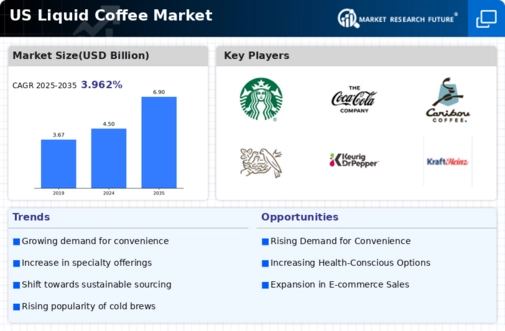The US Liquid Coffee Market is characterized by a dynamic landscape that combines strong brand identities with innovative product offerings. Competitive insights into this market reveal a saturation of premium, convenience-driven products that cater to diverse consumer preferences ranging from ready-to-drink coffees to specialty brews. As consumers increasingly gravitate towards convenience and quality, major players in this space are vying for market share through aggressive marketing strategies, product differentiation, and leveraging technology for enhanced consumer engagement.
The presence of both established brands and emerging startups contributes to an evolving competitive environment, which is likely to intensify as trends around health and sustainability continue to influence consumer choices.Starbucks has solidified its position as a premier player in the US Liquid Coffee Market through its extensive retail footprint and a well-formed brand loyalty. Known for its high-quality espresso beverages and seasonal offerings, Starbucks has created a unique experience that resonates with consumers looking for not just a product but an emotional connection.
The company leverages its strong brand equity to launch various innovative into its liquid coffee lineup, including cold brews and nitro coffees, which appeal to a wide array of customers. Additionally, its robust commitment to sustainability and ethical sourcing enhances its reputation and attracts socially-conscious consumers. Starbucks also benefits from a strong presence in both physical and digital spaces, ensuring that its products are accessible wherever its consumers are.CocaCola, traditionally a leader in the beverage sector, has made significant strides in the US Liquid Coffee Market through its strategic product diversification and acquisitions.
The company's entry into the coffee segment reflects its response to shifting consumer demand for convenient and ready-to-drink liquids. CocaCola has broadened its portfolio with key products like ready-to-drink coffee drinks that combine coffee with various flavorings, capturing a broad customer base. Furthermore, the acquisition of established coffee brands has served to enhance CocaCola’s market presence, allowing the company to leverage existing consumer familiarity and loyalty.
With a focus on innovative marketing campaigns and strategic partnerships, CocaCola continues to fortify its standing in the US Liquid Coffee Market, ensuring its offerings are not only competitive but also aligned to evolving consumer preferences for taste and convenience.























